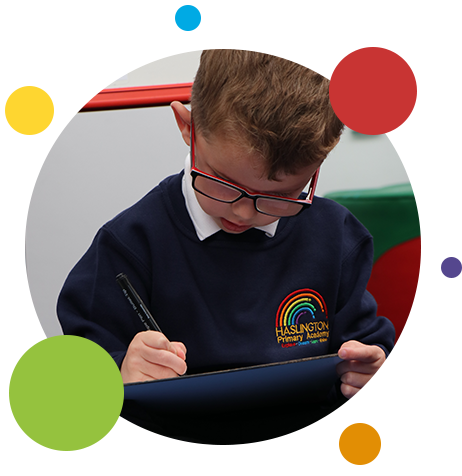EARLY LITERACY
At Haslington Primary Academy and Nursery we aim for all our children to become fluent, confident readers who are passionate about reading.
At Haslington Primary Academy and Nursery we use Read Write Inc Phonics (RWI) to give your child the best possible start with their literacy. This page contains guidance to how the RWI programme works together with some useful links showing how you can help your child at home. Please take the time to read the information as it will provide invaluable information as to how you can help and support your child in reading. If you have questions about phonics, please speak to your child’s class teacher in the first instance.

WHAT IS READ, WRITE, INC?
Read Write inc. Phonics is a daily approach to teaching literacy for children in early years and KS1 that creates fluent readers, confident speakers and willing writers. However, at Haslington Primary Academy and Nursery, we begin the programme in Nursery and will continue teaching RWI to children beyond the age of 7 if our children still need support in their reading.
It integrates phonics with comprehension, writing, grammar, spelling and handwriting, using engaging partner work and drama. The children learn to form each letter, spell correctly, and compose their ideas step-by-step.
More information on the programme can be found here
HOW WILL RWI BE TAUGHT?
All children are assessed regularly and will work with children at the same level in the RWI programme. This allows complete participation in lessons.
Five key principles underpin the teaching in all Read Write Inc. sessions:
Purpose – know the purpose of every activity and share it with the children, so they know the one thing they should be thinking about
Participation – ensure every child participates throughout the lesson. Partnership work is fundamental to learning
Praise – ensure children are praised for effort and learning, not ability
Pace – teach at an effective pace and devote every moment to teaching and learning
Passion – be passionate about teaching so children can be engaged emotionally.
When appropriate, children will be introduced to the initial sounds in short five minutes sessions during the Summer Term in Nursery. In Reception all children will learn how to ‘read’ the sounds in words and how those sounds can be written down. In Year 1 & 2 children follow the same format as Reception but will work on complex sounds and read books appropriate to their reading level. Daily sessions of RWI phonics last for one hour. Once children become fluent speedy readers, they will move on to literacy lessons.
PHONICS SCREENING CHECK YEAR ONE
What is the Year 1 phonics screening check?
The Year 1 phonics screening check is a short, light-touch assessment to confirm whether individual pupils have learnt phonic decoding to an appropriate standard.
It will identify the children who need extra help so they are given support by their school to improve their reading skills. They will then be able to retake the check so that schools can track pupils until they are able to decode.
Further information can be found here.
How Can I Help My Child?
HOW CAN I HELP MY CHILD?
Many parents wish to help their child at home to learn to read. When children are learning to read and write, it is much easier to make progress if they say the sounds in a pure way. This also helps children to segment words to spell them. Please watch the Phoneme Pronunciation Guide linked here to learn how to say ‘pure sounds.’
Here are some more key terms your will be using while learning through Read Write Inc.
Fred Talk We use the term Fred Talk to mean reading (blending) the sounds in a word to read that word. So cat is c-a-t. Use your fingers to count the sounds as you go.
Green Words are words that can be read by using Fred Talk.
Red Words are words that cannot be sounded out and need to be learnt by sight
How to practise Fred Talk with your child?
HOW TO PRACTISE FRED TALK WITH YOUR CHILD?
Read a green word to your child using Fred Talk (saying the sounds). Your child should blend the sounds to tell you the word. E.g. adult – “c a t”, child – “cat”
This time it is your child’s turn to do the Fred Talk! Give them one of the words and ask them to Fred Talk the word (tell you the sounds). It is important that children can do this orally before they begin to read and write the sounds. E.g. adult – “cat”, child – “c a t”
Encourage your child to count the sounds on their fingers as they go and then repeat it back to them also counting each sound on one finger. Ask questions such as ‘how many sounds were in that word?’ and ‘what was the initial sound (the first sound) of that word?’
To find out more about what your child will be learning during their Read Write Inc lessons and how to help them at home please read the Parent information booklets in the files to download below.
Follow this link to watch parent tutorials to learn more about how to support your child as they learn with Read Write Inc. Phonics, with detailed ideas and advice on pronouncing pure sounds, blending, and digraphs.